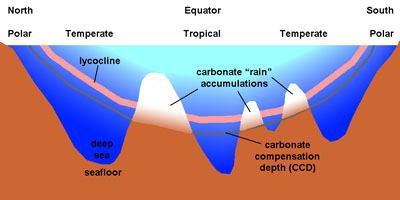6.21: Calcium Carbonate Compensation Depth (CCD)
- Page ID
- 10239
Calcium carbonate compensation depth (CCD)
Calcareous sediments are fairly evenly distributed in oceans, but their occurrence is influenced by the solubility of calcium carbonate. Calcium carbonate forms and is stable in shallow, warm seawater, but it will dissolve in cold seawater. Carbon dioxide dissolves easily in cold water, so CaCO3 will dissolve in cold water. The calcite compensation depth (CCD) is the depth in the oceans where the rate of calcium carbonate material forming and sinking is equal with the rate the material is dissolving. Below the CCD no calcium carbonate is preserved—generally there is no CaCO3 beneath about 15,000 feet (4500 meters) (Figure 6.81).
Skeletal remains composed of calcium carbonate (CaCO3) sinking into the deep ocean are mostly microscopic plankton. As carbonate materials settle or are moved by currents in to deep water, the smallest fragments dissolve before larger, denser fragments. The lysocline is the depth at which CaCO3 begins to dissolve rapidly.
 Figure 6.81. Relationship of the lysocline and the carbonate compensation depth (CCD) relative to depth of the ocean and latitude. The lysocline and CCD are at the surface near the poles where the water is cold. Calcareous oozes accumulate only above the CCD.
Figure 6.81. Relationship of the lysocline and the carbonate compensation depth (CCD) relative to depth of the ocean and latitude. The lysocline and CCD are at the surface near the poles where the water is cold. Calcareous oozes accumulate only above the CCD.


